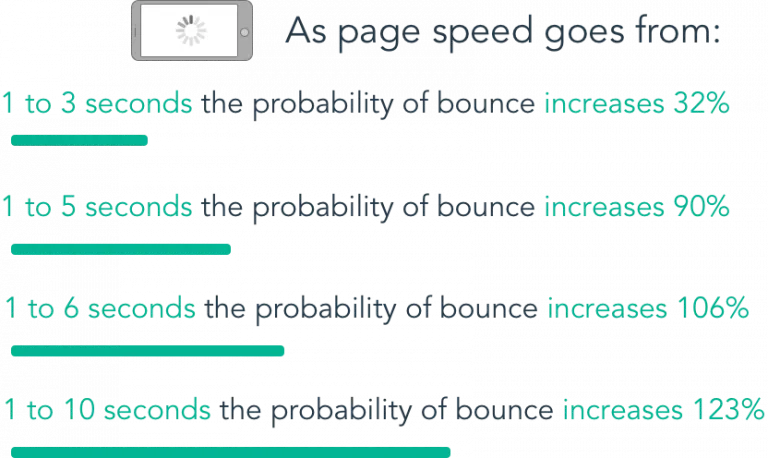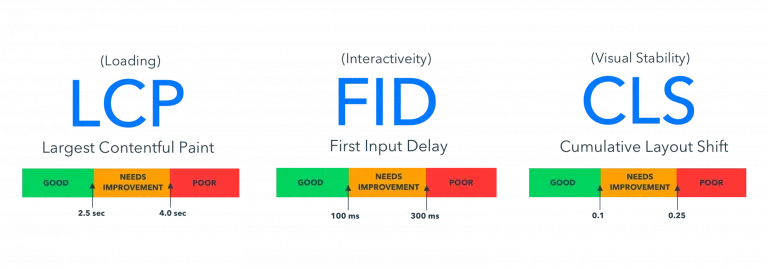Benefits of fast page speed
The benefits are two-fold. Page speed has a significant impact on how thoroughly both users and search engines are able to interact with your website.
Users bounce less, visit longer, convert more, and buy more on sites with fast page speed. Think about the alternative. In the same way that a customer would get frustrated waiting for an employee to help them in a physical store, they get equally (if not more) frustrated waiting for content to load and buttons to respond to their input.
Search engines crawl more pages, discover more content, and index more content on sites with fast page speed. Think about Google’s circumstances. They don’t have the time or resources to stick around to fully crawl and index sites that don’t load quickly.
According to a Google Survey, page speed is the single most important factor in user experience. So, if we look at the results, you’ll see that speed/load time topped other things we often think to be important to user experience “How easy it is to find things on the site” and “website design,” by a considerable amount.

Because speed is so important to user experience, it also has a significant impact on business. Users do not want to wait around for slow websites.

How to improve page speed
Simply put, the more success you have in business, the harder it is to maintain optimal site performance. Code, apps, scripts accumulate and become roadblocks. As brands grow and become more sophisticated, their websites become richer. And richness comes with a price. Performance issues scale as you grow and each issue has a tangible impact on the customer journey, from discovery to browsing to conversion.
Here are some basic level, but high-leverage, best practices to implement on your site to improve page speed:
- Using content delivery networks like Cloudflare
- Install a caching plugin like WP Rocket
- Minify HTML/CSS/Javascript files
- Compress your images with a short pixel
- Remove render-blocking Javascript
- Improve server response time
- Reduce the size of above the fold content
- Leverage browser caching
There are many helpful tools on the internet to find additional recommendations with in-depth directions for solutions. Here are a few that we recommend:
1. The Google Pagespeed Insights Tool.
This tool leverages lab data from the Google Lighthouse Report to generate an “overall” page speed score for your website on desktop and mobile devices. It also leverages field data from the Chrome User Experience Report to generate scores for your Core Web Vitals and whether or not you are passing that assessment. Additionally, there are sections on “Diagnostics” and “Opportunities”, which provide recommendations for how you can improve each of these scores.
2. The Google Lighthouse Report
This tool leverages lab data on six metrics - First Contentful Paint, Speed Index, Largest Contentful Paint, Time To Interactive, Total Blocking Time, and Cumulative Layout Shift - to generate a site performance score for your website. Similar to the Pagespeed Insights tool, there are sections on “Diagnostics” and “Opportunities”, which provide recommendations for how you can improve your score.
3. The Google Chrome User Experience Report
This tool leverages field data on 8 metrics, 4 of which (First Contentful Paint, Largest Contentful Paint, First Input Delay, Cumulative Layout) are displayed in the Pagespeed Insights tool, to measure how well real-world users are experiencing your website.
4. The Google Search Console - Core Web Vitals Report
This report uses field data accumulated from the Chrome User Experience report over the previous 3 month period to track and categorize website URLs based on how well (and whether) they are meeting the new Core Web Vitals requirements. It will be particularly relevant once the.
5. Google Search Console -Page Experience Report
This report shows the percentage of mobile URLs on your website with a “good” page experience, whether there are any page experience issues detected or “failing” URLs on your website, as well the number of impressions in organic search generated by those “good” URLs. It will be particularly relevant once the Core Web Vitals algorithm update is rolled out this summer.
How to get buy in to improve page speed
Most SEOs understand the importance of page speed. To get buy-in from the rest of the marketing team, web developers from the engineering team, or even the executive team if you are in a larger organization, explain the impact of page space speed on high-level financial goals. Communicate that improved site performance clearly leads to more business. Educate them on the fact that decreased site performance bleeds potential and existing customers, sometimes permanently. Expand on the fact that simple improvements can be quite high-leverage. Google has tons of case studies showing the connection between performance and revenue. You can see a whole list of stats on the relationship between performance and bounce rates and conversions here too.
While you are building your case for site performance projects, be prepared to address the following questions:
- What factors of my site most influence my business metrics?
- Which performance metrics should I focus on?
- How much faster do I need to make my site to see a measurable business impact?
- What would be the ROI for improving site performance?
- How much is slow performance costing the bottom line for my business?
- At what point should I expect to see diminishing returns on performance improvements?
THE RELATIONSHIP BETWEEN PAGE SPEED AND SEO
Google has been obsessed with page speed for over a decade. In 2010, they made desktop page speed a ranking factor. Then in 2018, they made mobile page speed a ranking factor. And in June 2021, they will be introducing a whole new set of performance-related ranking factors called “Core Web Vitals”.
With that said, there are over 200 ranking factors that make up Google’s algorithm and some have more weight than others. How important is page speed in the mix? It’s less important than the relevance and quality of the page’s content. You could be the fastest website on the internet, for example, but that won’t get you very high in the search engine rankings if the content isn’t great as well. As long as your page speed is in a reasonable range, it’s not going to hurt you.
That said, there are plenty of cases where page speed plays an important role in search results. Imagine a scenario, for example, where two sites are competing for a key industry query, they both have great content on the subject matter, but one loads faster and is more responsive than the other. In that case, page speed would serve as a sort of tie-breaking factor in which result is ranked higher.
Page speed has many indirect effects on search engine optimization as well.
If your site is slow, Google probably won’t put your crawl budget to optimal use. Fewer pages will be crawled. Portions of your website might remain totally unknown to Google. That means new and updated content won’t be discovered and added to search results as frequently, which of course means fewer opportunities to rank, garner impressions, and drive more organic traffic to the site.
Likewise, if your site is slow and unresponsive, users will probably get frustrated, spend less time on pages, visit fewer pages, bounce more often, convert less often, and are less likely to return ever again to find information or do business. Google considers a lot of these metrics in their algorithm too.
As mentioned earlier, page speed has renewed interest in the SEO community given the rollout of the Core Web Vitals update in the summer of 2021. New metrics - Largest Contentful Paint, First Input Delay, and Cumulative Layout Shift - are being introduced to measure the quality of a site’s user experience. Now, webmasters will have to focus improvements around how quickly the most important content in the initial window appears, how responsive buttons and links are, and how visually stable the page remains as new elements are loaded.
